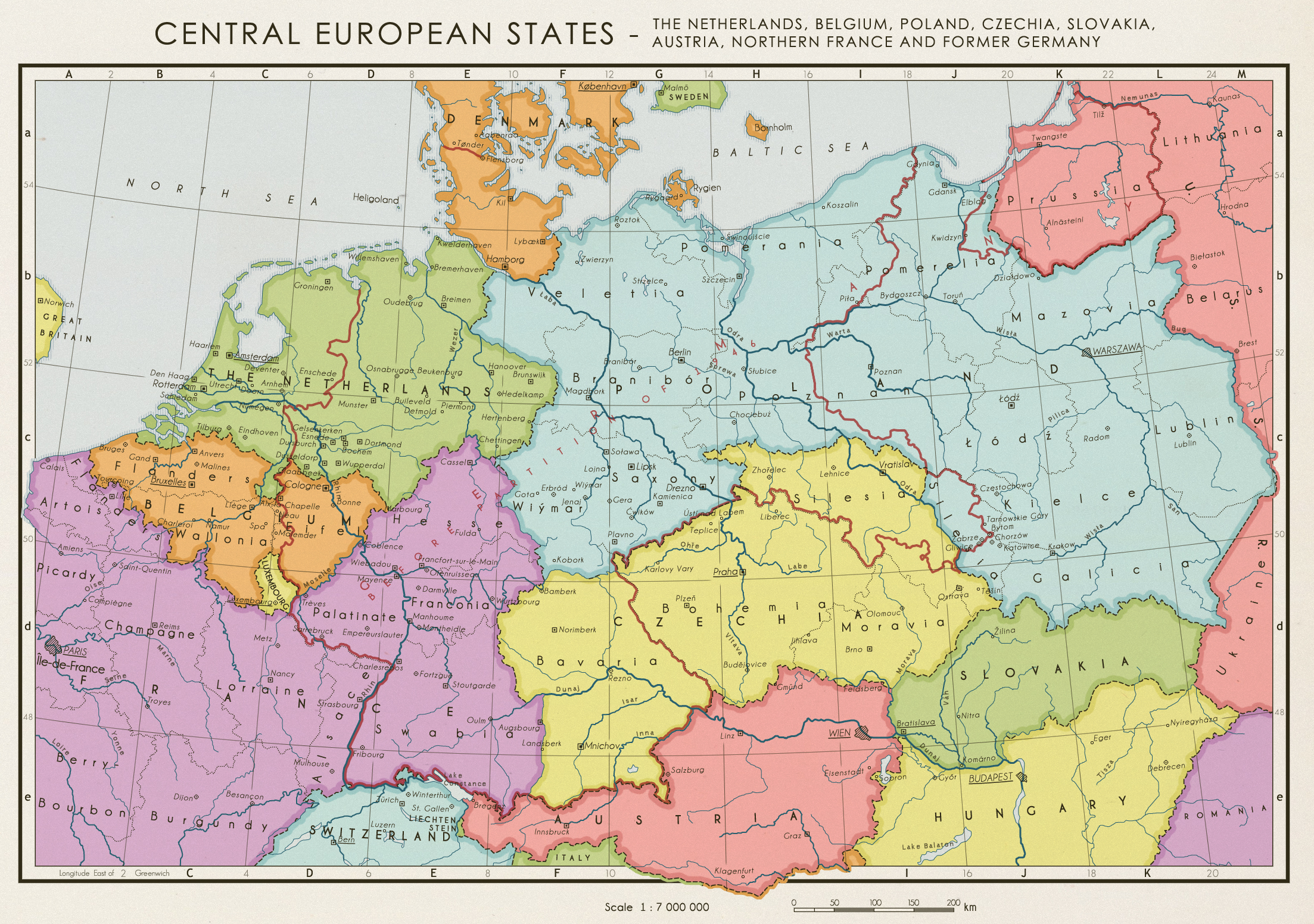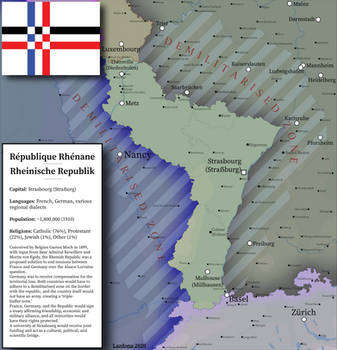ShopDreamUp AI ArtDreamUp
Deviation Actions
Description
“At the end of the 2nd World War, many plans existed on how to deal with the German question. Some argued Europe without Germany could not sustain itself economically and should be de-Nazified and rehabilitated. Others, fuelled by revenge for the damage caused by her, argued for the total extermination of the German state and people. The final plan was more like the latter than the former. “The warmongering German people” should pay for their crimes with territorial concessions to their neighbours, forced sterilisation of all adults deemed to be Nazis, and naturalisation of the remainder. To lower the population even further, Germans were denied food rations that were instead being sent to the remaining European population. It is estimated that between 15.000.000 and 20.000.000 Germans starved in the first five years after the end of the war.
Politically, Germany ceased to exist as a state in 1946, when it was divided between its neighbouring countries. Schleswig-Holstein, with the addition of Hamburg and the island of Rügen, became Danish. Prussia was incorporated as a republic in the Soviet Union. Mecklenburg, Pomerania, Brandenburg, Saxony, Thuringia, Danzig and the eastern, Polish populated part of Silesia was added to Poland. Czechia was extended with Bavaria to the west and Silesia to the north while Slovakia was made independent. Belgium annexed the Central Rhineland, and the Netherlands annexed Hanover and the Ruhr area. The remainder was annexed by France.
The controversial plan for the total annihilation of the German State and People was at the time seen as a necessity. However, historians today are beginning to look at it as the single greatest mistake of the 20th century. Some even go as far as to say that “Europe without a prosperous Germany is like America would be without the entire Midwest.” These theories are often looked down upon by stating that in less than 20 years, the GDP levels of Central Europe are already beginning to reach their pre-war level.
Supporters of the decision state that “an important factor that has to be taken into consideration is that humanity is saved from a potential Third World War, since there is no Germany to worry about”. – “A Brief History of the German People;” Adam S. Thompson: 1963
Life in all of these zones was harsh, in some zones possibly even harsher than it had been during the actual war. In the Polish and French zones the death rates were highest and most anyone could be put in jail, killed, or sterilised for even minor actions. Witnesses report that public executions occurred in both the French and Polish zones, though these claims are quite dubious. The death rates and living conditions nonetheless led to the German Exodus of 1948. About 10.000.000(of which only three quarters survived) migrated to Austria due to the “lenient” policies adopted by the American occupational authority there. The population of Austria is as of today more than twice as large as it was in 1945.
The inhabitants in the Dutch and Danish zones were quite lucky compared to this. A scheme was designed by the Danish government to determine which subjects to forcibly sterilise and which to neutralise (a similar scheme was adopted by the Dutch some time later). Could the person in question prove that they either actively opposed the Nazi government during the years 1933-1945, spoke another language than German as their first language or even had relatives living in Denmark (for the Dutch in the Netherlands) they escaped sterilisation.
The task of repopulating former Germany was solved differently by each nation. Poland, having lost a sizeable portion of its eastern territories to the Soviet Union resettled refugees from the East in the West. The first few years in the French zone looked quite dark, but when African nationalism rose in the mid-50s, the Pied-Noirs (French nationals living in Africa, primarily Algeria) were urged by DeGaulle to come home to the continent. Should they choose to settle in Swabia, Hesse, Franconia or the Palatinate they were given large benefits as opposed to “Old France”. The Belgian government chose to let most Germans stay, eventually creating a trilingual nation (French, Dutch and Saxon*). Denmark and the Netherlands, as stated above, naturalised large parts of the German population while sterilising and deporting only a few. Czechia could only be described as a mix of the other nations’ policies. In Prussia, the Old Prussian language was resurrected (together with lots of Lithuanian and Russian influence) and imposed on all Germans.
*Saxon is the Belgian version of German. It shares great similarities with Low German and Luxembourgish, with some French loanwords. It was imposed on everyone who did not wish to convert to Dutch or French.
Finished on April 5th, 2012
Politically, Germany ceased to exist as a state in 1946, when it was divided between its neighbouring countries. Schleswig-Holstein, with the addition of Hamburg and the island of Rügen, became Danish. Prussia was incorporated as a republic in the Soviet Union. Mecklenburg, Pomerania, Brandenburg, Saxony, Thuringia, Danzig and the eastern, Polish populated part of Silesia was added to Poland. Czechia was extended with Bavaria to the west and Silesia to the north while Slovakia was made independent. Belgium annexed the Central Rhineland, and the Netherlands annexed Hanover and the Ruhr area. The remainder was annexed by France.
The controversial plan for the total annihilation of the German State and People was at the time seen as a necessity. However, historians today are beginning to look at it as the single greatest mistake of the 20th century. Some even go as far as to say that “Europe without a prosperous Germany is like America would be without the entire Midwest.” These theories are often looked down upon by stating that in less than 20 years, the GDP levels of Central Europe are already beginning to reach their pre-war level.
Supporters of the decision state that “an important factor that has to be taken into consideration is that humanity is saved from a potential Third World War, since there is no Germany to worry about”. – “A Brief History of the German People;” Adam S. Thompson: 1963
Life in all of these zones was harsh, in some zones possibly even harsher than it had been during the actual war. In the Polish and French zones the death rates were highest and most anyone could be put in jail, killed, or sterilised for even minor actions. Witnesses report that public executions occurred in both the French and Polish zones, though these claims are quite dubious. The death rates and living conditions nonetheless led to the German Exodus of 1948. About 10.000.000(of which only three quarters survived) migrated to Austria due to the “lenient” policies adopted by the American occupational authority there. The population of Austria is as of today more than twice as large as it was in 1945.
The inhabitants in the Dutch and Danish zones were quite lucky compared to this. A scheme was designed by the Danish government to determine which subjects to forcibly sterilise and which to neutralise (a similar scheme was adopted by the Dutch some time later). Could the person in question prove that they either actively opposed the Nazi government during the years 1933-1945, spoke another language than German as their first language or even had relatives living in Denmark (for the Dutch in the Netherlands) they escaped sterilisation.
The task of repopulating former Germany was solved differently by each nation. Poland, having lost a sizeable portion of its eastern territories to the Soviet Union resettled refugees from the East in the West. The first few years in the French zone looked quite dark, but when African nationalism rose in the mid-50s, the Pied-Noirs (French nationals living in Africa, primarily Algeria) were urged by DeGaulle to come home to the continent. Should they choose to settle in Swabia, Hesse, Franconia or the Palatinate they were given large benefits as opposed to “Old France”. The Belgian government chose to let most Germans stay, eventually creating a trilingual nation (French, Dutch and Saxon*). Denmark and the Netherlands, as stated above, naturalised large parts of the German population while sterilising and deporting only a few. Czechia could only be described as a mix of the other nations’ policies. In Prussia, the Old Prussian language was resurrected (together with lots of Lithuanian and Russian influence) and imposed on all Germans.
*Saxon is the Belgian version of German. It shares great similarities with Low German and Luxembourgish, with some French loanwords. It was imposed on everyone who did not wish to convert to Dutch or French.
Finished on April 5th, 2012
Image size
2206x1552px 3.12 MB
© 2012 - 2024 1Blomma
Comments174
Join the community to add your comment. Already a deviant? Log In
Bavaria would more likely go to Austria, since theyre already "closely related"...
And also I think that Luxembourg should get at least a small part of the Pfalz (Palatinate) - probably the borderlands with the cities Trier (Treves), Koblenz (Coblence), and Saarbrücken (Sarrebruck).



















![[3770 x 2320] Map of The Tsardom of Russia in 1700](https://images-wixmp-ed30a86b8c4ca887773594c2.wixmp.com/f/1a2f6963-cbf6-4fbf-981f-37d30ab126d0/de0hmhc-573b0867-61be-4f83-9196-82bfac6fbee0.png/v1/crop/w_184)
















